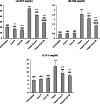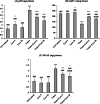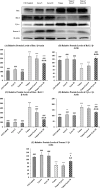Antioxidant, Antiinflammatory and Antiapoptotic Effects of Lycopene in Rats With Vancomycin-Induced Nephrotoxicity
- PMID: 40686206
- PMCID: PMC12278042
- DOI: 10.1111/bcpt.70084
Antioxidant, Antiinflammatory and Antiapoptotic Effects of Lycopene in Rats With Vancomycin-Induced Nephrotoxicity
Abstract
Background: The most important side effect of vancomycin (Vanco) is nephrotoxicity (NPT). Lycopene (Lyco) has been reported to have anti-inflammatory and anti-apoptotic properties in addition to its antioxidant activity. The aim is to investigate the protective efficacy of Lyco against the NPT condition that limits the use of Vanco.
Method: A total of 48 rats were used in the study in six groups of eight rats each, namely, Corn Oil Control, Lyco 5, Lyco 10, Vanco, Vanco + Lyco 5 and Vanco + Lyco 10.
Results: Vanco (400 mg/kg, intraperitoneal) administered for 7 days elevated serum BUN, creatinine, uric acid levels and renal lipid peroxidation while decreasing renal GSH and the activity of the antioxidant enzymes SOD, CAT and GPx. Vanco also increased the levels of inflammatory markers NF-κB, TNF-α, Bcl-3 and p38α MAPK activity. It decreased the level of AQP-1 and increased the level of NGAL. In addition, it activated apoptosis by decreasing Bcl-2 and Procas-3 expression levels while increasing apoptotic p53, Bax and Cyt-c expression levels. Lyco treatment at both doses (5 and 10 mg/kg, orally) ameliorated NPT by reducing oxidative stress, inflammation and apoptosis, while the higher dose was more effective.
Conclusion: The findings showed that Lyco attenuated Vanco-induced NPT.
Keywords: apoptosis; inflammation; lycopene; nephrotoxicity; oxidative stress; vancomycin.
© 2025 The Author(s). Basic & Clinical Pharmacology & Toxicology published by John Wiley & Sons Ltd on behalf of Nordic Association for the Publication of BCPT (former Nordic Pharmacological Society).
Conflict of interest statement
The authors declare no conflicts of interest.
Figures





Similar articles
-
Hesperidin ameliorates vancomycin-induced kidney injury via multipathway modulation: Nrf-2/HO-1, Caspase-3/Bax/Bcl-2, ATF-4, KIM-1 and improved renal tissue function.Biochem Pharmacol. 2025 Oct;240:117131. doi: 10.1016/j.bcp.2025.117131. Epub 2025 Jul 5. Biochem Pharmacol. 2025. PMID: 40623456
-
Study on the modulation of kidney and liver function of rats with diabetic nephropathy by Huidouba through metabolomics.J Ethnopharmacol. 2025 Jul 24;351:120136. doi: 10.1016/j.jep.2025.120136. Epub 2025 Jun 11. J Ethnopharmacol. 2025. PMID: 40513925
-
Selenium and Lycopene Ameliorate Methamphetamine-induced Neurotoxicity in Offspring Rats by Suppressing Oxidative Stress, Neuro-inflammation, and Apoptosis.Biol Trace Elem Res. 2025 Aug 23. doi: 10.1007/s12011-025-04685-z. Online ahead of print. Biol Trace Elem Res. 2025. PMID: 40849556
-
The Black Book of Psychotropic Dosing and Monitoring.Psychopharmacol Bull. 2024 Jul 8;54(3):8-59. Psychopharmacol Bull. 2024. PMID: 38993656 Free PMC article. Review.
-
NTP Developmental and Reproductive Toxicity Technical Report on the Prenatal Development Studies of 2-((1-(4-Phenoxyphenoxy)propan-2-yl)oxy)pyridine (CASRN 95737-68-1) in Sprague Dawley (Hsd:Sprague Dawley® SD®) Rats and New Zealand White (Hra:NZW SPF) Rabbits: DART Report 07 [Internet].Research Triangle Park (NC): National Toxicology Program; 2022 Jan. Research Triangle Park (NC): National Toxicology Program; 2022 Jan. PMID: 35593777 Free Books & Documents. Review.
References
-
- Gupta A., Biyani M., and Khaira A., “Vancomycin Nephrotoxicity: Myths and Facts,” Netherlands Journal of Medicine 69, no. 9 (2011): 379–383. - PubMed
-
- Bayomy N. A., Abdelaziz E. Z., Said M. A., Badawi M. S., and El‐Bakary R. H., “Effect of Pycnogenol and Spirulina on Vancomycin‐Induced Renal Cortical Oxidative Stress, Apoptosis, and Autophagy in Adult Male Albino Rat,” Canadian Journal of Physiology and Pharmacology 94, no. 8 (2016): 838–848, 10.1139/cjpp-2015-0600. - DOI - PubMed
MeSH terms
Substances
Grants and funding
LinkOut - more resources
Full Text Sources
Medical
Research Materials
Miscellaneous

